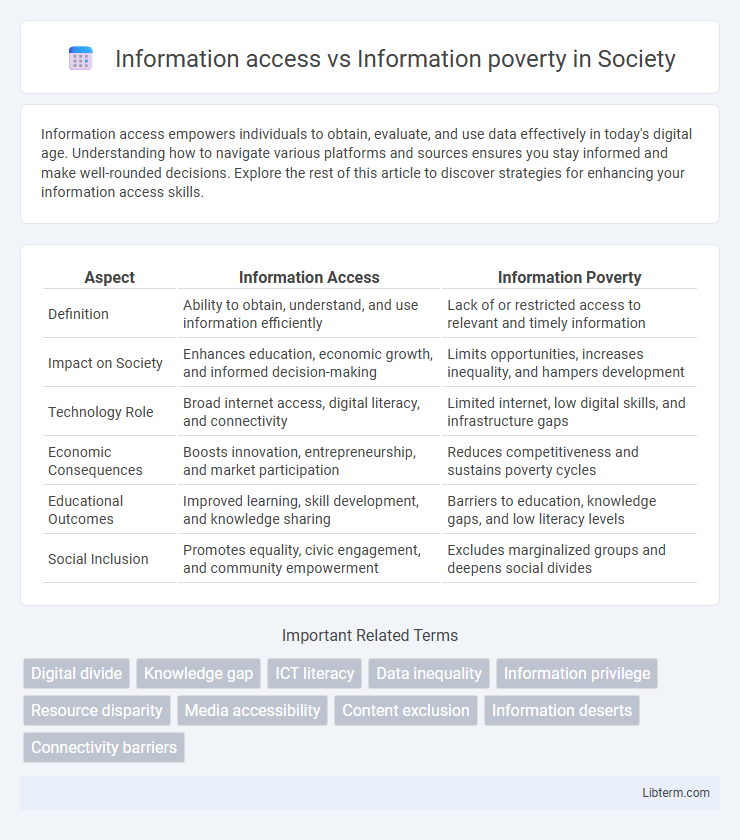Information access empowers individuals to obtain, evaluate, and use data effectively in today's digital age. Understanding how to navigate various platforms and sources ensures you stay informed and make well-rounded decisions. Explore the rest of this article to discover strategies for enhancing your information access skills.
Table of Comparison
| Aspect | Information Access | Information Poverty |
|---|---|---|
| Definition | Ability to obtain, understand, and use information efficiently | Lack of or restricted access to relevant and timely information |
| Impact on Society | Enhances education, economic growth, and informed decision-making | Limits opportunities, increases inequality, and hampers development |
| Technology Role | Broad internet access, digital literacy, and connectivity | Limited internet, low digital skills, and infrastructure gaps |
| Economic Consequences | Boosts innovation, entrepreneurship, and market participation | Reduces competitiveness and sustains poverty cycles |
| Educational Outcomes | Improved learning, skill development, and knowledge sharing | Barriers to education, knowledge gaps, and low literacy levels |
| Social Inclusion | Promotes equality, civic engagement, and community empowerment | Excludes marginalized groups and deepens social divides |
Defining Information Access and Information Poverty
Information access refers to the ability of individuals or communities to obtain, use, and share information through various digital and traditional channels, such as the internet, libraries, and media. Information poverty occurs when people lack adequate access to relevant, timely, and accurate information, leading to disadvantages in education, economic opportunities, and social participation. Bridging the gap between information access and information poverty is essential for promoting digital inclusion and equitable knowledge dissemination.
Historical Context of Information Inequality
Information access has historically been shaped by socioeconomic, racial, and geographic disparities, where marginalized communities often faced systemic barriers to education and communication technologies. Colonialism and segregation laws entrenched information poverty by restricting access to libraries, schools, and media, limiting knowledge dissemination among oppressed groups. Technological advancements have gradually reduced these gaps, but historical legacies continue to influence unequal information distribution worldwide.
Factors Influencing Information Access
Information access is influenced by factors such as digital infrastructure, socioeconomic status, education levels, and language proficiency, which determine the availability and usability of information resources. Information poverty occurs when individuals or communities lack access due to limited technology, inadequate literacy skills, or restricted content relevance, exacerbating knowledge gaps. Addressing these barriers requires targeted policies to improve digital literacy, expand connectivity, and provide culturally appropriate information services.
Causes and Consequences of Information Poverty
Information poverty stems from inadequate access to digital technologies, poor literacy skills, and socioeconomic barriers, limiting individual and community engagement with vital information resources. This deficiency impairs decision-making, educational attainment, and economic opportunities, perpetuating social inequality and exclusion. Persistent information poverty undermines democratic participation and exacerbates marginalized populations' vulnerability in an increasingly information-driven society.
The Digital Divide: Technology’s Role
The digital divide highlights the gap between information access and information poverty, where unequal distribution of technology limits opportunities for education, employment, and social participation. Access to high-speed internet, digital devices, and digital literacy are critical factors influencing this divide, perpetuating disparities in knowledge and resources. Bridging this gap requires targeted policies and infrastructure investments to ensure equitable technology availability and digital skills development.
Socioeconomic Impacts of Information Disparity
Information access significantly influences socioeconomic outcomes by enabling better education, healthcare, and employment opportunities, while information poverty exacerbates existing inequalities and limits social mobility. Communities lacking reliable access to digital resources experience reduced economic growth, lower levels of civic engagement, and diminished quality of life. Bridging the information gap is crucial for fostering inclusivity and equitable development across diverse populations.
Bridging the Gap: Strategies for Improving Information Access
Bridging the gap between information access and information poverty requires implementing inclusive digital infrastructure and promoting literacy programs that empower marginalized communities. Developing affordable internet services and expanding public access points like libraries and community centers enhance equitable information dissemination. Collaborative efforts between governments, NGOs, and private sectors drive sustainable solutions to mitigate information inequality worldwide.
The Role of Libraries and Public Institutions
Libraries and public institutions play a crucial role in bridging information access gaps by providing free, equitable resources to underserved communities. These entities offer digital literacy programs and affordable internet access, directly combating information poverty and promoting social inclusion. By curating diverse, reliable materials, libraries empower individuals with the knowledge necessary for education, employment, and civic participation.
Policy Interventions Addressing Information Poverty
Policy interventions addressing information poverty prioritize expanding broadband infrastructure and digital literacy programs to ensure equitable information access across underserved communities. Government initiatives such as subsidies for internet services and public access points in libraries effectively reduce barriers to digital resources. These measures enhance socioeconomic opportunities by bridging the digital divide and promoting inclusive participation in the information society.
Future Prospects: Achieving Information Equity
Expanding broadband infrastructure and affordable digital devices are critical for bridging the digital divide, enabling equal access to information across diverse populations. Emerging technologies like AI and 5G have the potential to democratize information by providing personalized and real-time knowledge, especially in underserved regions. Policies promoting digital literacy and inclusive content creation will play a pivotal role in transforming information poverty into equitable information access worldwide.
Information access Infographic

 libterm.com
libterm.com